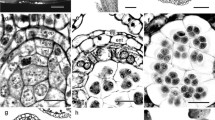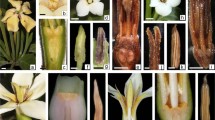Abstract
Flowers of Ruppia are usually arranged into an open two-flowered spike, but sometimes two lateral flowers are congenitally united with each other forming a terminal flower-like structure. This deviation from the morphogenesis of reproductive structures typical of Ruppia resembles those described in well-studied mutants of the model organisms of developmental genetics, such as Arabidopsis and Antirrhinum. A study of Ruppia allows the morphogenetic lability of this trait to be traced in natural populations. These data are important for understanding the evolutionary transition from open to closed inflorescences. This paper describes the first data on the frequencies of terminal flower-like structures in natural populations of Ruppia maritima as well as on the specific features of their morphogenesis. The vascular supply in the inflorescences with free and fused flowers is also compared for the first time. It has been demonstrated that the frequency of inflorescences with fused flowers considerably varies between different populations. The data on variation in the number of organs in flowers of plants from different populations suggest that an increased size of floral primordia is a factor enhancing their fusion into a joint primordium of the terminal structure. The vascular system of the R. maritima inflorescences with united flowers is similar to the vascular system of a single flower; moreover, nothing contradicts the hypothesis on a terminal position of this structure. The R. maritima inflorescences with united flowers frequently contain transversal stamens with an inverted polarity. Presumably, this is the first case of recorded inversion of relative polarity of stamens and carpels in angiosperms.
Similar content being viewed by others
References
Ambrose, B.A., Espinosa-Matías, S., Vázquez-Santana, S., et al., Comparative Floral Developmental Series of the Mexican Triurids Support a Euanthial Interpretation for the Unusual Floral Structures of Lacandonia schismatica (Lacandoniaceae), Amer. J. Bot., 2006, vol. 93, pp. 15–35.
Alvarez, J., Guki, C.L., Yu, X.-H., and Smyth, D.R., TERMINAL FLOWER: A Gene Affecting Inflorescence Development in Arabidopsis thaliana, Plant J., 1992, vol. 2, no. 2, pp. 103–116.
Aksenov, E.S., A New Method of Staining Plant Tissues for Preparation of Permanent Anatomical Specimens, Biol. Nauki, 1967, no. 11, pp. 125–126.
Barykina, R.P. Veselova, T.D., et al., Spravochnik po botanicheskoi mikrotekhnike. Osnovy i metody (A Handbook in Botanical Microtechnics: Principles and Methods), Moscow: Izd. Mosk. Univ., 2004.
Bradley, D., Carpenter, R., Copsey, L., et al., Control of Inflorescence Architecture in Antirrhinum, Nature, 1996, vol. 379, pp. 791–797.
Bowman, J.L., Axial Patterning in Leaves and Other Lateral Organs, Curr. Opin. Genet. Devel., 2000, vol. 10, no. 4, pp. 399–404
Bradley, D., Ratcliffe, O., Vincent, C., et al., Inflorescence Commitment and Architecture in Arabidopsis, Science, 1997, vol. 275, pp. 80–83.
Buzgo, M. and Endress, P.K., Floral Structure and Development of Acoraceae and Its Systematic Relationships with Basal Angiosperms, Int. J. Plant Sci., 2000, vol. 161, no. 3, pp. 23–41.
Buzgo, M., Soltis, D.E., Soltis, P.S., and Ma, H., Towards a Comprehensive Integration of Morphological and Genetic Studies of Floral Development, Trends Pl. Sci., 2004, vol. 9, pp. 164–173.
Choob, V.V. and Penin, A.A., Structure of Flower in Arabidopsis thaliana: Spatial Pattern Formation, Ontogenez, 2004, vol. 35, no. 4, pp. 280–284.
Choob, V.V., The Role of Positional Information in the Regulation of Development of Flower Organs and Leaf Series of Shoots, Doctoral (Biol.) Dissertation, Moscow, 2009.
Coen, E.S. and Nugent, J.M., Evolution of Flowers and Inflorescences, Development, 1994, vol. 120, pp. 107–116.
Dahlgren, R.M., Clifford, H.T., and Yeo, P.F., The Families of the Monocotyledons, Berlin: Springer, 1985.
Ezhova, T.A. and Penin, A.A., A New BRACTEA (BRA) Gene Controlling the Formation of an Indeterminate Bractless Inflorescence in Arabidopsis thaliana, Genetika, 2001, vol. 37, no. 7, pp. 935–938 [Russ. J. Genet. (Engl. Transl.), 2001, vol. 37, no. 7, pp. 772–775].
Gamerro, J.C., Observaciones Sobre la Biologia Floral y Morfologia de la Potamogetonacea “Ruppia cirrhosa” (Petag.) Grande (= “R. spiralis”, L. ex Dum.), Darwiniana, 1968, vol. 14, no. 4, pp. 575–607.
Kaul, B.R., Meristic and Organogeneitc Variation in Ruppia occidentalis and R. maritima, Int. J. Plant Sci., 1993, vol. 154, no. 3, pp. 416–424.
Kuznetsova, T.V., Morphology of Inflorescences: Current Status, in Itogi nauki i tekhniki. Ser. Botanika, Moscow, 1991, vol. 12, pp. 51–174.
Kuznetsova, T.V., Pryakhina, N.I., and Yakovlev, G.P., Sotsvetiya: morfologicheskaya klassifikatsiya (Inflorescences: Morphological Classification), St. Petersburg: Khim.-Farm. Inst., 1992.
Lacroix, C.R. and Kemp, J.R., Developmental Morphology of the Androecium and Gynoecium in Ruppia maritima L.: Considerations for Pollination, Aquatic Bot., 1997, vol. 59, pp. 253–262.
Liljegren, S.J., Gustafson-Brown, C., Pinyopich, A., et al., Interactions among APETALA1, LEAFY, and TERMI-NAL FLOWER1 Specify Meristem Fate, Plant Cell, 1999, vol. 11, no. 6, pp. 1007–1018.
Lock, I.E., Ashurkova, L.D., Belova, O.A., et al., A Continuum between Open and Closed Inflorescences? Inflorescence Tip Variation in Potamogeton (Potamogetonaceae: Alismatales), Wulfenia, 2009, vol. 16, pp. 33–50.
Markgraf, F., Bltenbau und Verwandtschaft bei den Einfachsten Helobiae, Ber. dt. Bot. Ges., 1936, vol. 54, pp. 191–229.
Mavrodiev, E.V. and Sokoloff, D.D., Morphology of the European Species of Zannichelliaceae, Ruppiaceae, and Zosteraceae, Byul. MOIP, Otd. Biol., 1998, vol. 103, no. 5, pp. 49–50.
Ordidge, M., Chiurugwi, T., Tooke, F., and Battey, N.H., LEAFY, TERMINAL FLOWER1, and AGAMOUS Are Functionally Conserved but Do not Regulate Terminal Flowering and Floral Determinacy in Impatiens balsamina, Plant J., 2005, vol. 44, pp. 1077–1082.
Penin, A.A., Choob, V.V., and Ezhova, T.A., Basic Principles of Terminal Flower Formation, Ontogenez, 2005, vol. 36, no. 2, pp. 92–95 [Russ. J. Dev. Biol. (Engl. Transl.), 2005, vol. 36, no. 2, pp. 65–69].
Posluszny, U. and Sattler, R., Floral Development of Ruppia maritima var. maritima, Can. J. Bot., 1974, vol. 52, pp. 1607–1612.
Rudall, P.J., Fascicles and Filamentous Structures: Comparative Ontogeny of Morphological Novelties in Triuridaceae, Int. J. Plant Sci., 2008, vol. 169, pp. 1023–1037.
Singh, V., Morphological and Anatomical Studies in Helobiae. II Vascular Anatomy of the Flower of Potamogetonaceae, Bot. Gaz., 1965, vol. 126, no. 2, pp. 137–144.
Sokoloff, D.D., Rudall, P.J., and Remizowa, M.V., Flower-Like Terminal Structures in Racemose Inflorescences: A Tool in Morphogenetic and Evolutionary Research, J. Exp. Bot., 2006a, vol. 57, no. 13, pp. 3517–3530.
Sokoloff, D.D., Remizowa, M.V., Timonin, A.K., and Oskolski, A.A., Fusions of Organs in the Flowers of Angiosperms: Typology and Taxonomic and Phylogenetic Significance, in Voprosy obshchei botaniki: traditsii i perspektivy. Materialy mezhdunarodnoi nauchnoi konferentsii, posvyashchennoi 200-letiyu Kazanskoi botanicheskoi shkoly (23–27 yanvarya 2006 g.) (Problems of General Botany: Traditions and Perspectives. Proceedings of the International Scientific Conference Devoted to 200 Anniversary of the Kazan Botanical School (January 23-27, 2006), Kazan, 2006b, Pt. 1, pp. 99–101.
Sokoloff, D.D., Oskolski, A.A., Remizowa, M.V., and Nuraliev, M.S., Flower Structure and Development in Tupidanthus calyptratus (Araliaceae): An Extreme Case of Polymery among Asterids, Plant Syst. Evol., 2007, vol. 268, pp. 209–234.
Troll, W., Die Infloreszenzen. Typologie und Stellung im Aufbau des Vegetationskörpers, Jena: Fischer, 1964.
Tomlinson, P.B., Anatomy of the Monocotyledons. VII. Helobiae (Alismatidae) (Including the Seagrasses), Oxford: Clarendon, 1982.
Tzvelev, N.N., Family Ruppiaceae, in Zhizn’ rastenii (Plant Life), vol. 6: Tsvetkovye rasteniya (Flowering Plants), Moscow: Prosveshchenie, 1982, pp. 34–35.
Uhl, N.W., Studies in the Floral Morphology and Anatomy of Certain Members of the Helobiae, Ph.D. Dissertation, Ithaca, New York: Cornell University, 1947.
Verbeke, J.A., Fusion Events during Floral Morphogenesis, Annual Rev. Plant Physiol. Plant Mol. Biol., 1992, vol. 43, pp. 583–589.
Weberling, F., Morphology of Flowers and Inflorescences, Cambridge: Cambridge University Press, 1989.
Zhao, L.-C. and Wu, Z.-Y., A Review on the Taxonomy and Evolution of Ruppia, J. Syst. Evol., 2008, vol. 46, pp. 467–478.
Author information
Authors and Affiliations
Corresponding author
Additional information
Original Russian Text © I.E. Lock, D.D. Sokoloff, M.V. Remizowa, 2010, published in Ontogenez, 2011, Vol. 42, No. 4, pp. 285–299.
Rights and permissions
About this article
Cite this article
Lock, I.E., Sokoloff, D.D. & Remizowa, M.V. Morphogenetic lability of the Ruppia maritima (Ruppiaceae, Alismatales) reproductive organs: From two lateral flowers to a terminal flower. Russ J Dev Biol 42, 247–260 (2011). https://doi.org/10.1134/S1062360411040084
Received:
Accepted:
Published:
Issue Date:
DOI: https://doi.org/10.1134/S1062360411040084




